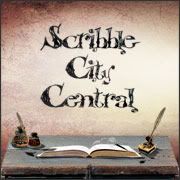Hello, Lucy, and thank you for letting me visit your lovely blog today. Excuse me while I remove my shoes and wriggle my toes a bit. So, where’s the fizz? Ah, there. Cheers!
So, synaesthesia. You’d like me to talk a bit about it. Since it’s one of my favourite topics, I’d be delighted!
What is it?
First, it’s NOT a medical condition or a negative thing. Second, almost everyone who has it has had it since birth, so they don’t know anything different. Often they don’t even know they have “something” that makes them different from the rest of us.
Yes, but what IS it, you annoying woman?
Well, it’s when two (usually, but occasionally more ) senses are oddly combined. The most common combination is hearing combined with seeing colours. So when you hear a particular sound you “see” a colour. Everyone with synaesthesia is different, but here are some examples of things that might happen:
- Certain sounds could make colours – for example when you hear particular musical notes or musical instruments, you see certain colours.
- Letters and numbers could have colours. If, for example, the letter ‘a’ was pink for you and ‘p’ was black, but ‘l’ was blue and ‘e’ butter yellow, the word ‘apple’ would produce all those colours.
- Similarly, days of the week (and months) could produce colours. That’s possibly the most common form of synaesthesia.
- Sounds could have shapes or tastes. One man talks of going to buy an ice-cream and finding that the voice of the ice-cream seller put such foul tastes in his mouth that he couldn’t face buying an ice-cream!
- Tastes could have shapes. In The Man Who Tasted Shapes, by Richard Cytowic, he tells of eating at someone’s house and the host talking about the chicken needing more spikes. (I can relate to this hugely.)
There’s more info here.
How do I know if I’ve got it?
Well, if you see yourself in any of those descriptions, you probably have. But there are some “rules” to establish if it’s true synaesthesia.
- The sensations must be physical and automatic. You would not have to think about them. For example, I can relate to giving shapes to tastes (and colours to sounds) but I can only do this by thinking, “What shape would salt be?” And I know it would be slightly curved, rounded, and warm. BUT, I’m doing this by thinking and it’s not an automatic reaction, but a cerebral one, taking into account meanings and sounds and everything. I do not have true synaesthesia. (When I visit Mary Hoffman’s blog on Dec 9th, I’ll show how most of us can “do” synaesthesia and how we can use it as a powerful writing tool.)
- The sensations must be the same every time. If Mondays are red to you today, they won’t be blue next week.
- You will be able to describe the sensations in extreme detail. Mondays won’t just be “red”, they will be the most specific type of red, and you’ll be able to describe it easily because you can really “see” it, either inside your head or actually in front of your eyes, like a screen. (Which is how Luke in Mondays are Red sees it.)
Is it useful for writers and artists?
I argue that true synaesthesia isn’t necessarily particularly useful! This is mainly because the correspondences are too individual and “odd”, rather than “meaningful” in a traditional or accessible way. (I’ll explain more on Mary’s blog.) So, they will feel surreal to the rest of us – nothing wrong with surreal but it makes it hard to share meaning. But some famously interesting writers and artists have or had synaesthesia and it certainly did them no harm! The writer Vladimir Nabokov, artists Kandinsky and David Hockney and the composer Messiaen and are the best known.
What’s it got to do with Mondays are Red, my novel?
Luke wakes from a coma and finds he has a very overwhelming synaesthesia – highly exaggerated and confusing. But he discovers that it gives him huge power, the power of language, which I argue is the greatest power of all – the power to change minds. He even discovers he can fly. (NB: you can’t. Please don’t try. Also, his power corrupts him, so you wouldn’t want it. Really.)
An amazing test
This works for people who have a very vivid form of coloured numbers or letters and is an amazing objective proof of the condition. (It’s rare for people to have it this strongly.)
Create a sheet of paper with lots of rows of the number five, but interspersed with a very few examples of the number two. Get a load of people to find and count the number 2s. Most people would take some time to do this, needing to look at each figure. BUT…people with this particular form of synaesthesia would find them instantly because the 2s would appear as a different colour to them. Even though they are printed in black. Amazing! (This test appears here and there are more interesting facts.)
Do you have synaesthesia? Do any of these things seem familiar?
At the launch of Mondays are Red, several adults discovered they had it because they all got into an argument about whether Mondays were red, green or silver! Whether you have synaesthesia or not, I hope lots of readers will want to enter Luke’s world. You need to let your imagination go but I promise you an exciting ride, even if you don’t actually fly!
Do hop over to Mary’s blog on Friday to read more about synaesthesia! Thank you, Lucy!
Thank you, Nicola. As always, it was a pleasure - and now I know I am not a colour synaesthete, although I do seem to feel particular tastes in my mouth with certain people and places...
PS: There's a fab (and very revealing) post about Nicola's music choices for writing over on Ros Morris's blog, The Undercover Soundtrack today, which ties in perfectly with this one. Do go and read it!
PS: There's a fab (and very revealing) post about Nicola's music choices for writing over on Ros Morris's blog, The Undercover Soundtrack today, which ties in perfectly with this one. Do go and read it!
Mondays are Red was Nicola Morgan’s debut YA novel, published in 2002. Nicola is now delighted to be producing the ebook, with a new cover and brand new extra material, including creative writing by school pupils inspired by the book. For details about how to buy see here. You don't need a Kindle to download it, and the price is approx £2.23 on Amazon and will be similar on other outlets (coming soon). There's also a wonderful trailer, made by Nicola's daughter, which you can see below:
About the bookWhen Luke wakes from a coma, his world has altered. Synaesthesia confuses his senses and a sinister creature called Dreeg inhabits his mind. Dreeg offers him limitless power – even the power to fly – and the temptations are huge, but the price is high. Who will pay? His mysteriously perfect girlfriend, with hair as long as the sound of honey? His detested sister, Laura, with the wasps in her hair? When Laura goes missing, Luke realizes the terrible truth about himself and his power. His decision is a matter of life and death, and he will have to run faster than fire.Nicola's next stop will be at Mary Hoffman's Book Maven blog on Friday 9th December.
Nicola's website is here
You can also find Nicola on Twitter (where she Crabbits regularly as @nicolamorgan).


















10 comments:
Morning, Lucy! Thank you for having me :) And thank you so much for your kind comments. x
I was very interested in this blog post because I have synesthesia, and like Nicola said, I have had it from birth. I discovered quite by accident one day, when listening to NPR on a road trip with my husband, that it was even a thing. I was shocked to find that I saw the world so differently. I of course went home and researched like crazy, to find out more. I would expect that many others would do the same and arrive here in their search.
Because of this, I would have to respectfully disagree with Nicola on two points. The first being, if you have to think about it, you don't have it. It truly is a visceral response when you think of a word or a letter, and it appears in your mind with color and texture and sometimes personality. But sometimes you do have to think about it, specifically when you are asked to describe it. The colors and texures can be so complex that the word 'red' or irredescent' fall flat to describe it, often times the word is layered in colors and textures. A word as a whole may be described as pink but the individual letters are blue and yellow so they are layered underneath it. So, please don't count yourself out, if you have to think about it for a moment.
Secondly, I would have to say that synesthesia is incredibly useful. I use it everyday in my professional life. I used to be an interior designer for many years, and I was a better designer because of my synesthesia. I am acutely aware of the tiniest variations in color, because there are so many variations in my synesthesia. I was better able to pair fabrics and paint swatches because of this, and that translates to my art as well.
But my synesthesia is at its most useful when I use it for remembering things. If you google synesthesia and photographic memory, you will find that there is a direct correlation between synethetes
because of their ability to see color. I do not have photographic memory, but with certain things, I can remember more detail because of my synesthesia.
But besides these two points, I think Nicola has it right. If it wasn't for this blog post, I would not have known about her book, and now I am really quite interested in it. I am completely intrigued to see synesthesia as a plot point. Thank you for this post, I look forward to reading.
Morgan - that is fascinating - again I have learnt something new. Thank you so much for commenting so fully. I can quite see how your synaesthesia helped your career as an interior designer. Do read MaR - I think you'll enjoy it, and will be interested to know what your reaction to it is. Do come back and tell us!
Such a fascinating post! And a fascinating insight from Morgan as well. Off to find out more!
Hello, Morgan. Lovely to hear from you. Ah, you misunderstood my first point (I wasn't clear, I can see. Sorry.) I didn't mean that if you had to think about what the colour exactly was, you didn't have it. I meant if you had to think about whether there was a colour response at all. It is (as defined by the experts) an involuntary, not deliberate, response. That's all I meant. Sorry I wasn't clear. And yes, as you say, you absolutely would need to think carefully before you could find the words to describe it - precisely *because* the experience is involuntary.
On your second point - it's possible that you're coming to the same conclusion as some dyslexics do when they say that having dyselexia has made them better at something else. We don't really know that because we don't know whether your colour sensitivity is due to your synaesthesia or a separate and coincidental colour skill. For example, i believe I also have colour skills/sensitivity such as you describe but I do not have synaesthesia. And Im not an interior designer! Also, some synaesthetes, because their responses are unusual, wouldn't necessarily make good interior designers, i don't think! (I have no evidence for saying that, other than theory/hunch.)
However, it's very important to recognise that everyone is different so i really don't want to sound dogmatic at all. My findings are based on research over many years into lots of people with variations of the conditions and from conversations with the experts in the condition. But we also believe what accords with our existing beliefs and I'm doubtless guilty of that, too.
You are completely right about synaesthesia often being useful as a memory tool - I hope you've read Daniel Tammet? (Born on a Blue Day) I was meaning useful for writers - I think it's usually less useful than people think, for the reasons I give and in Mary's post. Of course (as said) many creatives are synaesthetic but many are not and many synaesthetes are not creatives, so there's a question over any individual cause and effect.
By the way, if you read Mondays are Red to throw a light on science of synaesthesia, you'll find it won't. It's fiction!
oops, clicked post before saying: thank you for all your comments and to Lucy for hosting me. x
My daughter realised that she had synesthesia (although she didn't know that label then) when, in an English lesson in Year 7 her teacher asked how Bronte had evoked the fire in Jane Eyre so vividly. Annie shot up her hand to say that she'd used lots of red and orange words, then had a sudden feeling that maybe nobody else would understand that thought, so kept it to herself! She's got a brilliant memory, by the way.
Pippa
Fascinating! Thanks to all concerned. I don't have synaethesia, but my first editor, the lovely Phyllis Hunt, did. I remember her telling me what colours the days of the week were for her. I think she said that Monday was a yellowish-green and Tuesday was bright blue, but I can't recall the rest.
Hi Lucy - this is to let you know that I've awarded you one of the Leibster blog awards it is mine to give!
It's given to blogs with fewer than 200 followers, who deserve more. The rules are - you thank the person who gave it you on your blog; post the badge on your blog - and then give out 5 Leibsters to blogs of your choice.
I'm not technically savvy enough to send you the badge, but you can pick it up from my site.
Best wishes and - great blog!
Post a Comment